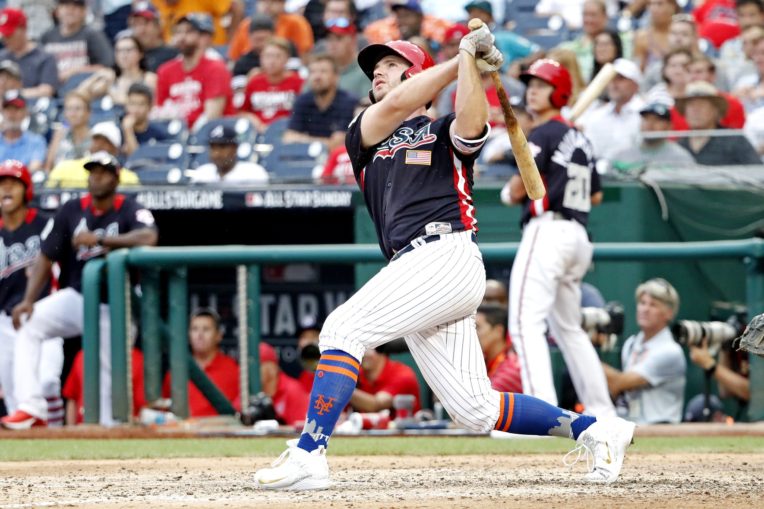
We’ve beaten the phrase “exit velocity” to death in sports media, and lord knows I’ve piled on my fair share. But it’s undeniable that hitting the ball hard produces results – the league leaders in exit velocity are consistently among the most productive players in baseball. In that sense, we should concern ourselves with a players’ exit velocity talent – hitting the ball hard is a truly valuable skill for a player, and their ability to succeed in the majors can depend on that ability.
Take Ike Davis versus Lucas Duda for example – the Mets gave Duda the first base job in 2014 over Davis because Duda had the edge in exit velocity. Four years and 108 HR later, Duda has been a capable 1B option for most of his career, while Davis is in rookie ball – pitching. We’re right to be concerned about this.
In that sense, it makes sense that we should be concerned about Peter Alonso’s exit velocity as well. It’s almost the same situation as 2014: the Mets have two young first-base guys (Alonso and Dominic Smith) and there are arguments to be made for both. While Smith has struggled with discipline in the majors, the exit velocity talent is there for Smith: Smith’s career average exit velocity in the MLB is 88.7 MPH, about 1.5 MPH harder than league average from 2017-2018.
If Smith’s discipline improves, he could be an above-average hitter! It’s a big “if” given how Smith has looked in the majors, but the possibility still exists for Smith to live up to that top-100 prospect pedigree. So the question is – does Alonso have some edge over Smith the same way that Duda had an edge over Davis?
Alonso can easily post better discipline numbers than Smith – Smith’s atrocious plate discipline in 2018 (31.5% K%, 2.7% BB%) set the bar quite low. Smith might have an edge over Alonso in terms of defense – if we believe the Mets that evaluators are truly concerned about Alonso’s defense and not simply coming up with an excuse to manipulate Alonso’s service time. And both Alonso and Smith are pretty slow on the basepaths. So essentially, it comes down to exit velocity – in terms of the other aspects of their games, it’s essentially a wash between the two except for the category where one player’s talent is unknown.
Well, unknown to us. MiLB and MLB games are tracked with the Trackman system. The majority of this information is proprietary, as MLB teams pay good money for these systems and don’t want to share that information with the world for free, but some of that information for MLB games is made public via BaseballSavant – that’s how we know what Dominic Smith’s average exit velocity is.
The Mets most certainly know what Alonso’s average exit velocity is in the minors, but they’re not telling – so we have a blind spot except for glimpses and snatches of Alonso’s batted ball data in games where that kind of information is made public on special occasions.
Peter Alonso has now hit a 110 MPH homer in the Fall Stars Game, a 113.6 MPH homer in AFL game and 113.6 MPH homer in the Futures Game this year.
— Michael Mayer (@mikemayerMMO) November 4, 2018
Having finished with the Arizona Fall League game, we have basically three glimpses of Alonso’s batted ball talent. They’re all extremely good! But it’s just three batted balls. According to Russell Carlton of Baseball Prospectus, exit velocity stabilizes quickly at around 40 batted balls – in other words, if we have exit velocity data from 40 batted balls, those 40 batted balls will tell you pretty reliably what a hitter’s exit velocity in future batted balls will be – but three batted balls is a far cry away from 40.
Still, those three batted balls are information, and that information is valuable. Rob Arthur indicated that just one batted ball might be enough to predict a breakout for a hitter, and we might be able to make something out of these snatches here.
Consider the following plot – 2018 average exit velocities versus 2018 maximum exit velocities for hitters with at least 200+ balls in play (the minimum to qualify for Baseball Savant’s leaderboards).

In general, a player’s maximum exit velocity is correlated to their average exit velocity – not strongly, but the relationship certainly exists. The point remains, as this chart and Arthur illustrate – a players’ ceiling can be indicative of their average as well. In that sense, these glimpses can mean something if we assume the worst case scenario for Alonso – that the small sampling of batted balls presented represent his exit velocity ceiling.
You might also think that there’s a quality of talent component, but Alonso is registering these batted balls against some of the top competition in the game. An MLB hitter will face a decent number of arms with a AAA talent level in the majors, and an MiLB hitter will face a decent number of arms with an MLB talent level in AAA.
To be sure, Alonso is registering more at-bats against a lower talent level than the MLB – but consider that Alonso’s HR in the Fall League game came off of a 103 MPH fastball. Since 2008 when pitch-tracking began, no one has ever homered off of a 103 MPH fastball. Nobody. Alonso is facing a worse quality of talent overall, but make no mistake: the glimpses and snatches we’re getting are against elite talent.
So let’s consider that Alonso has hit a baseball 113.6 MPH this year. Only 84 players in the MLB recorded a max exit velocity higher than that out of 945 players who produced at least one batted ball. That’s significant.
Let’s consider that Alonso has hit two baseballs 113.6 MPH this year. Only 47 players in the MLB have recorded two balls with an exit velocity higher than that out of 872 players who produced at least two batted balls. That’s also significant.
If we go by our rough model relating maximum exit velocity to average exit velocity above, Alonso’s approximate exit velocity (assuming that 113.6 MPH is his exit velocity ceiling) is 89.7 – a full mile per hour faster than Smith. That’s an unreliable figure (we’re working with a model with an R2 of just .4644), but it’s not completely meaningless.
If you really want evidence that Alonso has the edge on Smith in terms of exit velocity, then this might convince you: Alonso’s hardest hit balls that we know of are 110 MPH, 113.6 MPH, and 113.6 MPH. Smith’s hardest hit balls in the majors since debuting are 106.9 MPH, 107.5 MPH, and 108.8 MPH.
There’s always this caveat of uncertainty – maybe Alonso got really lucky against a 103 MPH fastball, and maybe Smith has some kind of hidden EV talent. But based on these glimpses and snatches, it looks like Alonso has the edge over Smith.















